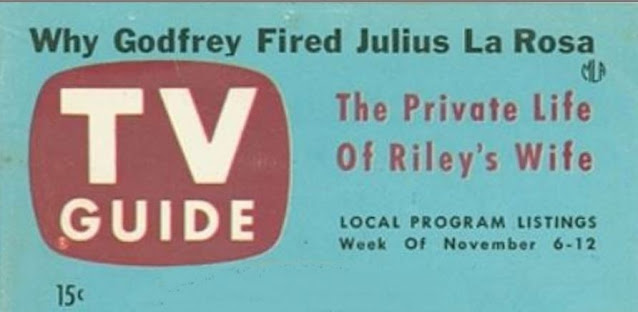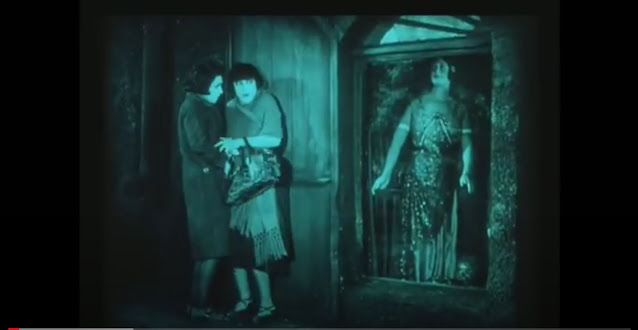Greta Garbo's Films Get the TV Guide Treatment -- Part 1
Before cable TV and the streaming services, people used to buy each week's issue of TV Guide, a small magazine designed to fit on an end table in the living room. If you were unwilling to pay to get info on your favorite programs, a brief schedule for over-the-air television shows did appear on the inside back page of the front section of the newspaper. Ah, newspapers. . . Remember those? The large multi-part paper compendiums of recent news events which came to your house each day?
A quick nostalgic look at the TV listings page from a now-vintage newspaper reminds us all why people bought TV Guide if they could afford it.
During the 1930s and 1940s, in the golden age of old-time radio, there was no TV Guide yet, of course. The popular program listing magazine was Radio Guide, which at times was also called Movie and Radio Guide.
The magazine folded in 1943, and ten years later the first issue of TV Guide was published. Twenty years after that, around 1973, I began searching out old movies in the family copy of TV Guide.
At that time, old movies were a staple of over-the-air broadcasting. The broadcast day was uneven, with commercial-laden blocks of shows separated by a vast wasteland of stuff no one would buy ads.
A media analyst named Newton Minow (Newton's a funny name, right?) famously did tthis presentation in 1961 on the state of what was available on what people called "the boob tube." He was the person who first referred to TV programming as a "vast wasteland."
Television, when I was young, was something men and families mainly watched in the evenings, and low-quality daytime programs were aimed at women (and unemployed men, I suppose). These were mostly daily morning chat shows followed by soap operas and game shows. After that came syndicated sitcoms for which no one had to pay residuals. Even that stuff got thin and local stations could only run "Gomer Pyle" so many times.
And this is why there were so many cool old movies on television when I was growing up. Vintage movies were used to fill the gaps because they used up lots of time and the films didn't show overtly sexual scenes. Murder yes, domestic violence yes, horrifying racism yes, but no exposed cleavage. Plus the old flicks were free. The copyrights were expired and film reels were bought by the boxful by TV stations when movie distributors didn't want the old prints taking up warehouse space.
Then the VCR appeared, and old movies were transferred to brick-shaped black plastic tape cartridges. Because professionally-manufactured videotapes were pricey collector's items. But those of us who loved cinema fare of the 30s to the 50s were thrilled by the opportunity to take stuff off the TV. After some struggle, we did learn (eventually) to program the video recorder to tape whatever movie was on Channel 12 at 3:30 a.m.
We movie-accumulators needed TV Guide more than ever so we could search the late-night listings for treasure. Each issue was compact, designed to grab off a sofa cushion for a quick consultation, so there was very little room for film descriptions. And this is where the fun began.
Some underpaid lackey at the publishing office had to type in a super-short summary of each film, and it was obvious that none of the decision makers the magazine's big office cared what the descriptions said.
So a movie like 1933's "King Kong" was in regular rotation and a lackey would find a new way to describe the plot of "King Kong" in a couple of pithy phrases: "Giant ape escapes, grabs girl, climbs building."
So I've taken on the task of describing each of Greta Garbo's films as though I am writing for TV Guide. I do realize that the average person on the street doesn't know that Greta Garbo was an actress, and I imagine that maybe one in fifty people could name two movies she was in. (One person in a hundred?) So why do I bother, you may be wondering?
In the post-apocalyptic novels I love to read, there are always a few people who preserve as much culture as they can, for the use of future generations once that little waves-of-deadly-radiation issue has been dealt with. So I thought it might be a public service to provide capsule summaries of Greta Garbo's films, starting with the silents in 1925 and going till her last motion picture in 1941.
Before we begin the list: If you would like to learn the origins of each film, here's a link to a previous post about the silent films Garbo made, all of which are on today's list. And now, here we go!
Garbo's first major movie performance was in "The Saga of Gosta Gerling" in 1924.
Summary: Garbo plays a Countess, Elizabeth, caught up in intrigue as a wealthy woman, the owner of a nearby estate, is stirring up trouble. The truth behind the scandal is revealed. Whew. But is all well? No. eear the end of the film, Elizabeth and her love interest, the defrocked minister Gosta, don many layers of furry clothing, including hats so big they look like they have actual minks sitting on their heads.
The couple then get into a sled and zoom across a massive frozen lake, then they stop for a chat. Gosta puts his head into Elizabeth's lap and begs her forgiveness. Elizabeth looks him lovingly, then gets out of the sled and walks into a snowy forest lane bounded by tall skinny dark trees which remind me of Ivanka Trump's scary Christmas decor.
The next title in Garbo's filmography is "The Joyless Street." It's a comedy. (Not.)
And the last plot summary for today is for the film "Torrent."
Both the poster and a plot summary I read somewhere online indicate that there's a physical flood in this romantic silent film, but I've only seen pieces of the movie so that's all I know about the deep water part.
I do know that Garbo plays a Spanish peasant girl in love with a handsome aristocrat. There's a sweet scene in a meadow. The handsome fellow has arrived on horseback and then has climbed over a stone wall to profess his love. He and his girlfriend are planning to meet up in Paris, as soon as he gets permission from his dowager mother.
But the very reason Garbo's character and her old father are leaving for Paris is because her boyfriend's mother has just kicked them out of their peasant cottage. As the couple talks over the matter, the young woman's doubts vanish when she sees an omen -- white doves flying out of the village bell tower The peasant girl blesses herself, knowing God will fix everything. But alas. . ..
Mr. Handsome Beret Guy kisses a flower before giving it to his love.
It was some film crew member's job to keep flinging white doves from this bell tower.
Next week, more Greta Garbo movies in summary form.
Garbo





















Comments
Post a Comment